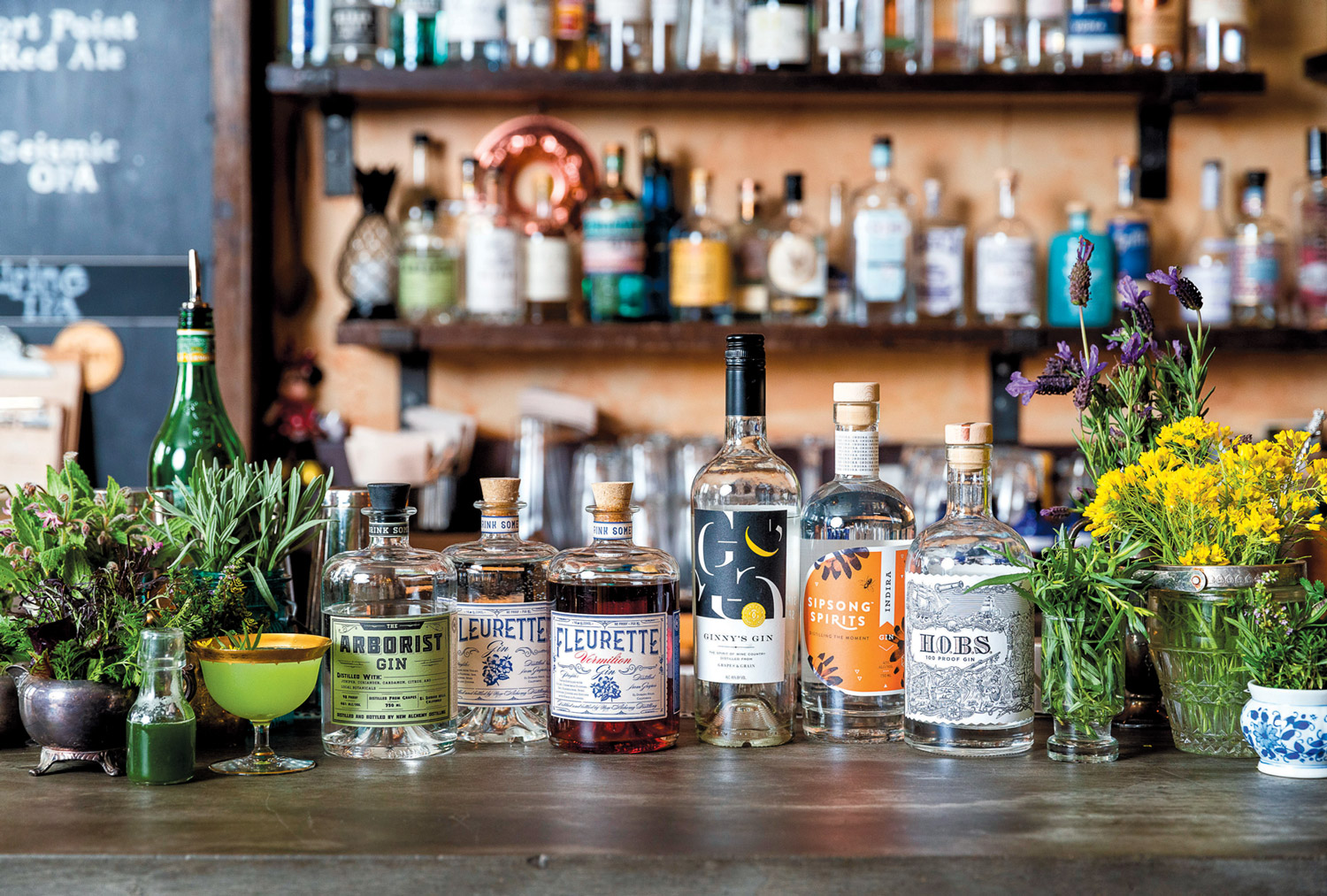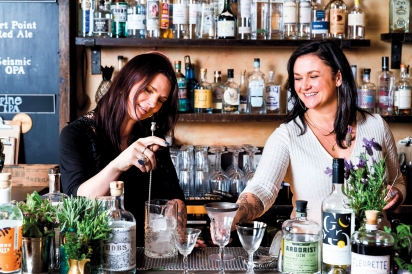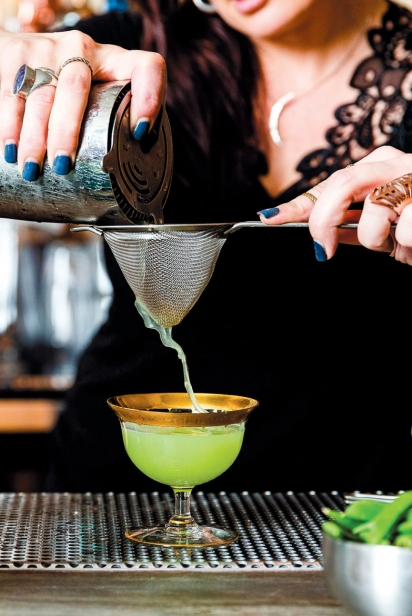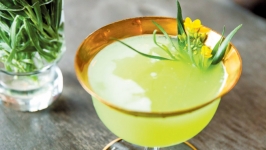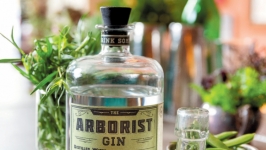The Alchemy of Gin
LOCALLY DISTILLED GINS MAKE FOR HERBACEOUSLY SPRING-Y LIBATIONS
Spring is my favorite season. It always feels so full of potential—the kind of potential that must make its way into the world, no matter what.
Herbs, my greatest passion, are also abundant in spring. In the forest and in the garden, the appearance of tender herb sprouts amongst the winter-barren landscape assures us that life has, once again, prevailed.
If there is a spirit of spring, it’s gin—potently alive with herbaceous botanical flavors. Especially in the hands of a gifted distiller. Gins and gin cocktails are all over the food and drink news these days, and our area is right there amongst the buzz. There are a handful of new and exceptional gin distillers here in Edible Marin & Wine Country-land and a crew of talented mixologists who are turning their spirits into uniquely delicious cocktails.
As spring approached this year, my thirst for gin-based libations germinated, so I headed to my favorite local watering hole, Healdsburg’s Duke’s Spirited Cocktails, to get a jump start on the season. Laura Sanfilippo and Tara Heffernon, two of the three co-founders of Duke’s, take an almost nerdy scientific approach to crafting their wildly creative cocktails. They’re also fellow herb geeks and ardent supporters of the local agricultural scene, offering one of the most extensive farm-to-glass drink menus around.
My visit with Laura and Tara delivered not only a jubilant buzz, but an education on the history, science and many nuances of gin. With over 60 different gins on offer at Duke’s, the choices were overwhelming, so I asked these experts to introduce me to a few of their favorite locally distilled gins, which they were happy to do.
While I savored my first gin drink (The Lucinda Walker: Fluerette gin, raspberry, thyme, lemon, egg white and rose petal bitters), and before any talk about herbs and gin and how to mix them began, I was schooled on gin. And I do mean schooled—my mind was blown as to how little I knew about gin.
WHAT IS GIN, EXACTLY?
The U.S. Bureau of Alcohol and Tobacco Tax and Trade defines gin as “A spirit with a main characteristic flavor derived from juniper berries produced by distillation or mixing of spirits with juniper berries and other aromatics or extracts derived from these materials and bottled at not less than 40% alcohol by volume (80 proof ).” The vagueness of this legal definition allows distillers significant room for creativity, and they take it.
Jason Somerby, one of the proprietors of New Alchemy Distilling in El Dorado, California, points out that, in addition to many new distillers choosing to use less juniper flavor in their gins, there are also around 50 different juniper varietals available to distillers today, unlike times past. Most traditional gin distillers use an Italian varietal cultivated specifically for use in flavoring gin. Most of the newly emerging varietals are wild foraged. Delving even deeper into the nuances, Jason shares that he and his team have been surprised that “the origin of the berries seems to matter as much as the specific varietals, in terms of flavor.”
Laura and Tara also note that the way in which juniper flavor is extracted from the berries and then used in the gin-making process is equally varied. All of these potential variations in ingredients and process, and the resulting spirits, have led to the establishment of subcategories within the overarching category of gin as a spirit.
New World–style gins use a greater range of botanicals than the traditional Old World–style, juniper-forward gins. London Dry gin, with its classic combination of coriander, citrus peel, angelica and, of course, juniper, falls into the latter category. Most of the “Navy Strength” style gins also fall into the Old World category.
Jason identifies the craft beer movement as a pivotal precedent for small artisan distillers. “In the 1990s, there were a handful of producers manufacturing beer on massive scales. As new craft breweries appeared, they were able to resurrect old and unique beer recipes, as well as experiment with new recipes, where the big guys with mass production infrastructure never could.” The same, he says, is true in distilled spirits and, specifically, gins: “Whole production lines made to continuously produce traditional, heavy juniper-based gin in big industrial stills called ‘continuous stills,’ opt for increased production numbers vs. high-quality and tasteful product.”
He goes on to posit that these mass-production stills are unable to take “true heads, tails and cuts,” key steps of the distilling process. More often than not, the spirit is stripped of all flavor, leaving a completely neutral spirit to be flavored after distillation. Craft distillers, using smaller-scale equipment with more opportunity for distiller “manipulation,” are more able to retain many of the nuances of the botanicals during distillation.
WHERE WAS GIN FIRST DISTILLED?
Genever is the Dutch name for juniper, and also the malty, Scotch-like spirit with massive amounts of herb and spice undertones that is gin’s ancestor. The spirit originated in Holland and/or Belgium, somewhere around the 1500s, when juniper and sugar were added to a base spirit. As the Dutch East India Company increased its dominance over world trade routes, more and more exotic ingredients were added.
Sailors traveling between ports traded genever, and when British troops joined Dutch soldiers in the Thirty Years War, the spirit earned the nickname Dutch Courage, helping soldiers muster up the “spirit” to fight.
The British government, in an effort to keep the economic benefits derived from all of this “courage” imbibing closer to home, began to subsidize the distillation of a genever-like spirit from grain. The new product, dubbed “gin,” was significantly different than genever, in part because of the lack of quality raw materials, and also because of a lack of technical skill in the distillation process. So, to be precise, what we now know as gin was born in England.
HOW IS GIN MADE?
Gin is produced in varying manners. One way is to first distill a neutral base spirit, technically a vodka, then add botanicals, allowing them to infuse until the desired flavor is obtained. In other methods, various botanicals are actually distilled as part of the base spirit. The resulting spirit may or may not then be infused with additional botanicals, and may or may not have water or sweetener added.
According to Laura and Tara, each botanical reacts differently to the distilling method in which it is used, and even the timing of its addition into the process, lending differing flavors or notes accordingly. Laura reminds me of the artistry involved: “The distillation process is an art form for the makers; a lot of trial and error occurs in determining which methods of distillation can extract the specific essence desired.” Tara adds, “Sometimes they discover something magical by accident, too. It often it happens that way.”
LOCALLY DISTILLED GINS
HOBB’S GIN, YOUNG & YONDER SPIRITS, HEALDSBURG
The husband-and-wife team of Josh and Sarah Opatz have been making a splash in the local craft distilling world since they left their “regular” jobs in San Francisco and moved to Healdsburg to make booze.
Young & Yonder’s Hobb’s Gin is also a happy marriage—of a corn-based spirit and botanicals. It has all of the texture and voluptuousness you expect of a corn-based spirit, slightly sweet with a finish that is smooth and slightly candied. Blending the right botanicals is the tricky part, as corn-based spirits often have a residual flavor or finishing note of corn that does not complement juniper. Josh and Sarah have figured it out, producing a strong and clean gin that pays homage to potent Navy Strength gins, without going overboard on either juniper or proof.
Made with 100% non-GMO corn and water from the Russian River, Hobb’s Gin is flavored with juniper, lemon peel, coriander and lavender. The citrus and lavender balance the juniper beautifully.
Laura & Tara’s Tasting Notes: This gin has a smooth, rich and creamy mouthfeel and pleasant sweetness from the corn base. White florals, citrus forward with elegant and elevated juniper notes. Plays well with others but also stands alone. We love drinking it up, with a twist.
NEW ALCHEMY DISTILLING, EL DORADO HILLS
If everything they make is truly an expression of themselves, this distillery’s gins are the most scientifically based gins of the bunch. New Alchemy’s founders Matt Sweeney and Douglas “DJ” Boyle met in a research laboratory where the idea for making well-crafted small batch spirits was born. The bios of the rest of their team also read like a science lab roster, littered with PhDs and educators.
The cumulative smarts at New Alchemy are combined with rare artistry, producing three unique gins made from grapes grown in the Wine Country and all wild-foraged botanicals which they distill using proprietary techniques to achieve an exceptionally bright base. From recipe development to custom-designed vapor-path stills to the bottling process, it’s clear that these folks are serious about their spirits.
Arborist Gin
A London Dry–style gin, modernized by the inclusion of 14 different botanicals including juniper from Italy and the Baltics. It’s named “Arborist” for a reason, its scent evocative of the forest. Fresh and clean with peppery, citrus and spice notes, this gin is extremely versatile and easy to use in cocktails.
Laura & Tara’s Notes: Drinks clean and green with notes of sage, spruce tips, bay laurel, bell pepper and finger lime. It’s like a walk through a California forest in springtime.
Fleurette Gin
This gin showcases the floral and citrus qualities of many New World–style gins. The nose is reminiscent of a well-made perfume, in a good way. This is due to the use of 11 different botanicals including Baltic juniper, which is more floral than the traditional Italian varietal. Many of the other florals included are locally grown in the Healdsburg area.
Laura & Tara’s Notes: Fields of violets, lavender and iris. Lots of purple florals and bursts of coriander, lemon zest and citrus blossom. It’s striking, and at the same time pretty.
Fleurette Vermillion Gin
The New Alchemy folks took their Fleurette Gin and turned it into something completely different by infusing it with hibiscus petals and orange blossoms for their Fleurette Vermillion Gin. They also added a small amount of local Sebastopol honey, to offset the somewhat tannic nature of hibiscus. The finished product is soft, sweet and sensual. Because of the intricacies of production, this gin is produced in very small batches—less than 100 bottles at a time.
Laura & Tara’s Notes: Sweeter and lighter than the original Fleurette. Acidic and full of tannins. A fruitiness comes into the picture with the hibiscus infusion.
GINNY’S GIN, WINDSOR
In 2016, Virginia “Ginny” Sweeney, then a stay-at-home mom to two teenage boys, took over a “hobby” gin producer developed by five high-profile winemakers when the founders decided to move on to other interests. The British native, who refers to her gin as “Mother’s Milk,” and her three current partners have turned the venture into a thriving business that is quickly making room for itself on bar and retail shelves all over our area.
The recipe, developed over seven years by the founding team of winemakers who started out just wanting to craft a gin to enjoy themselves, is a beautiful marriage of grapes and grain (in this case, corn), with the perfect amount of balance and restraint, much like a fine wine. The gin is bottled in a wine bottle, paying tribute to its roots.
This gin is reminiscent of Ginny herself—strong, feminine, courageous and British. It has a definite juniper backbone that points to the London Dry style, while its heavy citrus blossom nose takes me to California. It feels well made, with an extraordinary texture. Coriander’s peppery, lemony and grassy notes jump out for me, which makes sense as both coriander seeds and juniper berries are cracked and then macerated with the grapes before being distilled together with other botanicals including wild sagebrush from the Lake Tahoe area. Corn is introduced during a second distillation. This process results in several layers of overlapping tones and notes that appear throughout the tasting experience.
Laura & Tara’s Notes: This is a great “gateway” gin. It’s light and citrusy on the nose. Very citrus forward, yellow sweet corn and lemon custard. The botanicals feel delicate, yet the spirit is potent.
INDIRA GIN, SIPSONG SPIRITS, HEALDSBURG
Some of us are better than others at following our own curiosities. Sipsong Spirits proprietor Tara Jasper is highly skilled at this endeavor. She is a licensed pilot and avid flier, and it’s safe to say that even the sky isn’t the limit for her.
Tara’s gin “curiosity” began when this stay-at-home mom with a culinary degree began making fruit liquors and shrubs as gift s for friends and family. But a hobby for Tara isn’t like a hobby for ordinary folks—she took it to the next level. Researching everything she could on the subject as a means to improve her handmade elixirs, she began making eau de vie, then fermenting and moved on to distilling. An “aha” moment made her realize that all her geeking out had taught her how to make gin.
Her path, and her spirit, illustrate the true essence of the small-batch craft distiller: A genuine passion for experimentation is key. An inquiring mind and nerdy attraction to understand the way things work is a must. A visceral need to bring an idea to fruition is also mandatory.
According to Tara, Sipsong means “intuition,” and, in a world where intuition seems to have been forgotten, she reminds us of its power.
New World–style gins are described as such because they push the boundaries of traditional gins, showing way outside-the-box flavors. Sipsong’s Indira Gin takes this to an entirely new level. One of the most celebrated locally distilled gins of the moment, Indira Gin is wildly weird, and incredibly alluring.
Tara’s 100% grape-based gin pairs her favorite culinary traditions, Indian and Thai. This is a cumin, cardamom and coriander-forward gin, with equally forward juniper notes, which sounds impossible to do well, but she does. It tastes like what I imagine a gin from the “spice trade days” might have tasted like. It’s bright and savory and fresh all at the same time. One of the most unique gins on the market today, it is guaranteed to evoke your own spirit of experimentation.
Laura & Tara’s Notes: Bold but very well balanced. East Indian spices make this an exciting gin to use. Cumin, coriander, lavender and kafir lime.


